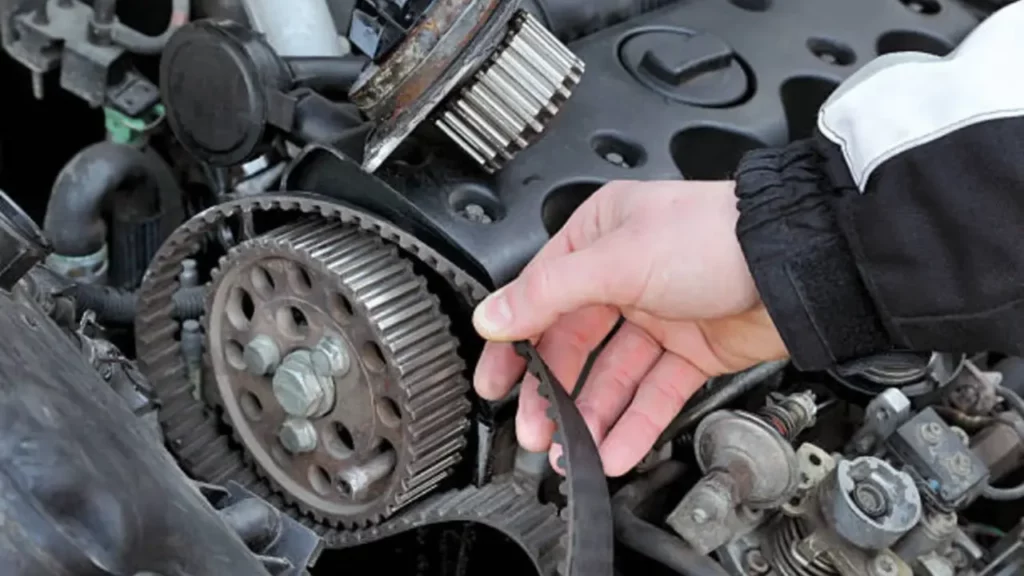In more recently manufactured vehicles, the timing belt is a rubber belt that synchronizes the actions of the camshaft and crankshaft to keep your valves safely moving and your engine running. In older vehicles, the timing belt may actually be a chain. Regardless, the purpose is the same, and it is important to the functioning of your vehicle.
The timing belt makes sure everything in the engine is operating smoothly, keeping you safe on the road. Replacing the timing belt is an important maintenance item! So, if you own a car, you should understand how a timing belt works and when to replace it.
What is a Timing Belt?
In a piston engine, either a timing belt or timing chain or set of timing gears is used to synchronize the rotation of the crankshaft and the camshaft. This synchronization ensures that the engine’s valves open and close at the correct times in relation to the position of the pistons.
The job of the timing belt is to harmonize crankshaft and camshaft rotation, and if both are synced up properly, then your vehicle’s pistons and valves will operate correctly. This is important because, as fuel is being ignited in the combustion chamber, your vehicle’s valves control fuel/air mixture intake and exhaust gas and push your pistons down.
The camshaft operates the valves in your engine to let in and out air and gas. The crankshaft moves the pistons up and down. These two systems have to operate in exact synchronization or damage could occur to the valves, pistons, engine, or other nearby parts. It is the job of the timing belt to ensure this synchronization occurs by keeping each system turning at the correct rate.

Timing Belt vs. Timing Chain
Depending on your vehicle model, you might have a timing chain instead of a timing belt. A timing chain functions the same as a belt, but it is metal instead of rubber. Because they are lighter and quieter, timing belts became popular to use after they were introduced in the 1960s.
Thanks to design improvements and a long lifespan, many modern cars have returned to using timing chains instead. If your car has a timing chain instead of a timing belt, you may be able to go longer before replacing the timing chain. As always, check your owner’s manual or give us a call to be sure.
What A Timing Belt Is Made Of?
Modern timing belts are constructed of rubber, synthetic rubbers like neoprene, polyurethane, or highly saturated nitrile, with high-tensile strength reinforcing cords made of Kevlar, polyester, or fiberglass.
The reinforcing cords will run the length of the belt, to reduce the tendency of the belt to stretch out over time. Timing belts have trapezoidal or curvilinear teeth cut into one of the sides and these teeth are specially shaped and sized to connect properly with the pulleys on the crankshaft and the camshaft.
Engines with timing chains will have oil flowing over the chain to lubricate and protect the parts. Oil can damage rubber, so engines with rubber timing belts will typically be constructed in a “dry” setup, where oil or coolant does not interact with the belt.
When Should You Replace the Timing Belt?
The suggested timing belt replacement period is between 60,000 miles and 90,000 miles. It’s essential to get your timing belt replaced per your owner’s manual. Putting off a belt service is risky and could lead to significant damage.
Timing belts are strong and highly efficient but being constantly under stress and operating in high-heat environments make them impossible to last forever. However, drivers widely forget that timing belts must be replaced on a regular basis.
If you don’t replace the timing belt at the recommended time, you could end up with total engine failure, broken or bent valves, cylinder head or camshaft damage, and piston and cylinder wall damage.
This is not the type of situation where it’s safe to think: ‘If it’s not broke, don’t fix it.’ Replace the timing belt according to the manufacturer’s maintenance schedule to avoid thousands of dollars repairing or replacing your engine.
Signs Of Bad Timing Belt
Here are some of the signs you need to look out for if your timing belt is bad and needs to be replaced.
- The engine misfires.
- Ticking noise coming from the engine
- Oil leaks from the front of the motor
- The engine acts up between 2000 – 4000 RPM.
- More smoke and fumes than normal
- The engine won’t turn over.
- Check Engine Light Is On
While your vehicle is in for service, we recommend also replacing the water pump. The water pump usually has a similar lifespan and is easy to access when the timing belt is off—that way you save money on labor costs.
How Much Does It Cost to Replace a Timing Belt?
If you have experienced one or more of the symptoms above it’s best to have a certified, quality auto repair specialist inspect your vehicle as soon as possible.
If your timing belt is in need of replacement, you can expect that service to cost anywhere from $300 up to $500. Because the timing belt is not easily reachable on many vehicles there is a good bit of disassembly and reassembly needed to get to the belt.
Economy cars with smaller engines require less labor. But larger trucks, SUVs, or luxury vehicles often require much more time.
Can You Drive with A Bad Timing Belt?
No, you cannot. We could really stop right there, but it’s probably best to elaborate a bit. If you suspect the timing belt is bad and you keep driving, you’re looking at the potential for bent valves, damage to the cylinder head and camshaft, and the potential for other internal engine damage. The costs can add up quickly.